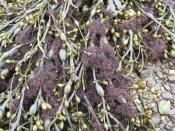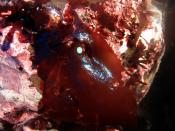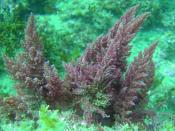Division Rhodophyta: Red Algae
This type of algae contains single-celled forms as well as plants that grow as filaments, branching structures and broad flat plates or ruffles. All of this type of algae lives attached to a surface such as a rock, coral reef, animal shell or larger algae. In red algae, no flagellated cells occur. Red algae have chlorophyll a and phycobilins and carotenoids are its accessory pigments. It stores food with a starch-like polymer. It resides in tropical coral reefs and plays an important role in reef building. The algae become encrusted with calcium carbonate that is extracted from the sea, which adds material to the reef which was constructed by coral animals that secrete calcium carbonate tubes around themselves. Red Algae contain carrageenan which is used in puddings, candies and ice cream (found in Irish moss). Agar is also found in red algae; it's used for a laboratory culture for microorganisms.
Division Phaeophyta: Brown Algae
Brown Algae are the most complex, largest type of algae. It's multicellular and contains chlorophylls a and c. Brown algae are thought to have evolved from chrysophyte ancestors due to the fact that they have similar food storage molecules and contain the carotenoid pigment fucoxanthin. Brown algae generally live in cool, shallow waters along the sea coast in temperate and subpolar areas. An example of brown algae is Fucus, which grows a foot or more in length using a specialized holdfast to attach itself. A stalk-like stipe connects it to the blades which are flat and photosynthetic. The blades are buoyed up to near the surface of the water by air bladders, which are gas-filled. Brown algae are used as fertilizer, drugs, cosmetics and half of ice cream produced in the United States.
Division Chlorophyta: Green Algae
Green algae can both...


